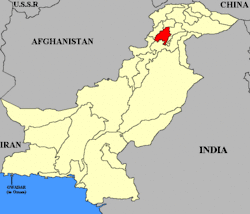Swat (princely state)
State of Swat (Urdu: رياست سوات; locally called as Dera Swat) was a kingdom established in 1849 by the Muslim saint Akhund Abdul Gaffur, more commonly known as Saidu Baba,[1][2] that was ruled by chiefs known as Akhunds. It was then recognized as a princely state in alliance with the British Indian Empire between 1926 and 1947, after which the Akhwand acceded to the newly independent state of Pakistan. Swat continued to exist as an autonomous region until it was dissolved in 1969,[3] and incorporated into Khyber Pakhtunkhwa Province (formerly called NWFP). The area it covered is now divided between the present-day districts of Swat, Buner and Shangla.
State of Swat Pashto: رياست سوات | |
|---|---|
| 1849–1969 | |
 Flag | |
 | |
| Capital | Saidu Sharif |
| Religion | Islam |
| Government | Princely state in alliance with British India (1858–1947) Princely state of Pakistan (1947–1969) |
| Wāli of Swat | |
| History | |
• Established | 1849 |
• Merged into North-West Frontier Province | 28 July 1969 |
| Currency | Rupee, Pakistan Rupee (after 1947) |
| Today part of | Pakistan · Khyber Pakhtunkhwa |
 |
| This article is part of the series |
| Former administrative units of Pakistan |
|---|
History
The modern area of Swat was ruled sporadically by religious leaders, who variously took the title of Akhund.
Saidu Baba was born at Jabrai, a village in the Upper Swat valley in 1794 AD.[4] He is locally said to be of Gujjar origin,[5][6] while the family claims belonging to the Safi branch of the Mohmand tribe.[5] Beginning his life as a shepherd, he left the village at the age of 18 and settled in the village of Mian Brangola, where he got his early education and learnt the fundamentals of Islam.[4]
Saidu Baba conferred a scheme for a united throne of Swat. In 1849, he nominated Sayyid Akbar Shah, a descendant of Pir Baba, as the emir of the State of Swat. After Akbar Shah's death in 1857, Saidu Baba assumed control of the state himself till his own death in 1878.[7]: 40
Government
The rulers of Swat held the title Amir-e Shariyat and from 1918 were known as Badshah; the title changed to Wali in 1926 when it became a Princely State of the British Raj. Since 1969 the former princely state has been under a civil administration as part of Khyber Pakhtunkhwa.[3]
| Tenure | Rulers of Swat |
|---|---|
| 1849 - 11 May 1857 | Sayyid Akbar Shah |
| 11 May 1857 - 1878 | Akhund Abdul Ghaffur (Saidu Baba) |
| 1878–1916 | State in abeyance, no proper accepted ruler |
| 1916 - September 1918 | Syed Abdul-Syed Abdul Jabbar Shah Shah |
| September 1918- 12 December 1949 | Miangul Abdul Wadud (Badshah Sahib) |
| 12 December 1949 – 28 July 1969 | Miangul Abdul-Haqq Jahan Zeb |
See also
References
- S.G. Page 398 and 399, T and C of N.W.F.P by Ibbetson page 11 etc
- Fredrik Barth, Features of Person and Society in Swat: Collected Essays on Pathans, illustrated edition, Routledge, 1981
- Claus, Peter J.; Diamond, Sarah; Ann Mills, Margaret (2003). South Asian Folklore: An Encyclopedia : Afghanistan, Bangladesh, India, Nepal, Pakistan, Sri Lanka. Taylor & Francis. p. 447. ISBN 9780415939195.
- Inam-ur-Rahim; Viaro, Alain M. (2002). Swat: An Afghan Society in Pakistan : Urbanisation and Change in Tribal Environment. City Press. pp. 77–79. ISBN 978-969-8380-55-7.
- Inam-ur-Rahim; Viaro, Alain M. (2002). Swat: An Afghan Society in Pakistan : Urbanisation and Change in Tribal Environment. City Press. p. 69. ISBN 978-969-8380-55-7.
- Beattie, Dr Hugh; Beattie, Hugh (16 December 2013). Imperial Frontier: Tribe and State in Waziristan. Routledge. p. 312. ISBN 978-1-136-83957-3.
- Haroon, Sana (2011). Frontier of Faith: Islam, in the Indo-Afghan Borderland. Hurst Publishers. ISBN 978-1849041836.
Further reading
- The Last Wali of Swat: An Autobiography as Told by Fredrik Barth (Asian Portraits), by Fredrik Barth
- Sack, John (2000). Report from Practically Nowhere. ISBN 0-595-08918-6.
- Sultan-i-Rome, Swat State, 1915–1969, From Genesis to Merger: An Analysis of Political, Administrative, Socio-Political, and Economic Development, Karachi: Oxford University Press (2008), ISBN 0-19-547113-X
- Sultan-i-Rome. Forestry in the Princely State of Swat and Kalam (North-West Pakistan): A Historical Perspective on Norms and Practices, NCCR IP6 Working Paper No. 6. Zurich: Department of Geography, University of Zurich (2005)
<ref.yousafzai ki sargazishit by allah bakhash yousafi>
- Miangul Aurangzeb: The last Vali Ahad (Crown Prince) of the former Swat State